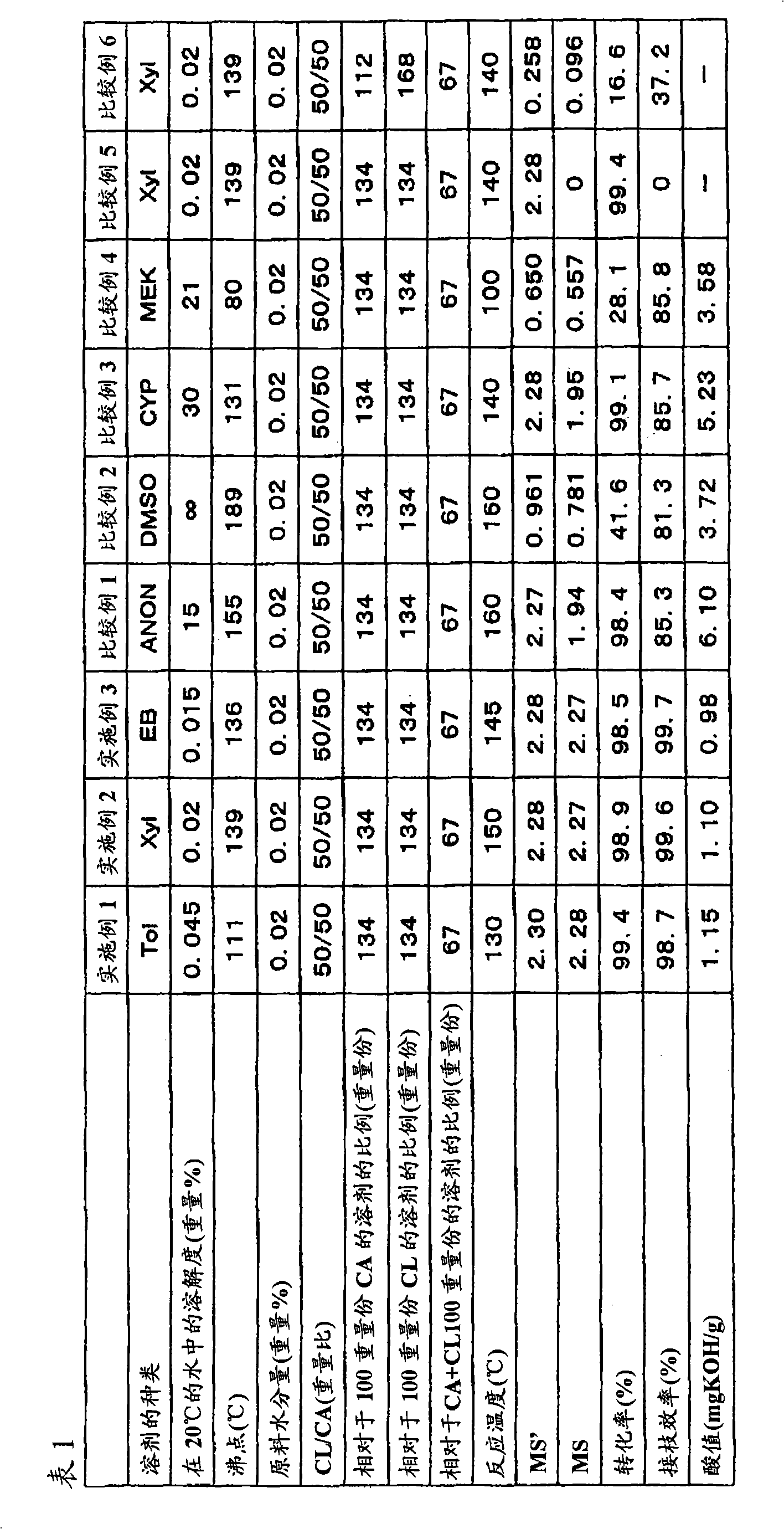Method for producing cyclic ester-modified glucan derivative
A manufacturing method, dextran technology, applied in the field of molded products, can solve problems such as rising manufacturing costs, complicated procedures, and damage to the fluidity of the product, and achieve the effects of inhibiting the formation of homopolymers and high grafting efficiency
- Summary
- Abstract
- Description
- Claims
- Application Information
AI Technical Summary
Problems solved by technology
Method used
Image
Examples
Embodiment 1
[0146] In a reactor with a stirrer and anchor-type stirring blades, add 50 parts of cellulose acetate (manufactured by Daicel Chemical Industry Co., Ltd., L-20, the average degree of substitution is 2.41, the molecular weight of each glucose unit 263.2, a specific gravity of 1.33, and an average degree of polymerization of 140), and dried under reduced pressure at 110° C. and 4 Torr (= about 530 Pa) for 4 hours. Then, the reactor is purified with dry nitrogen, a reflux condenser is installed, and 50 parts of ε-caprolactone and 67 parts of toluene (Tol) that have been dried and distilled in advance are added, heated to 130 ° C, stirred, and the cellulose acetate The ester dissolves evenly. The moisture in the dissolved reaction solution was measured with a Karl Fischer moisture analyzer and found to be 0.02% by weight. 0.25 parts of monobutyltin trioctoate was added to this reaction liquid, and it heated at 130 degreeC, stirring for 3 hours. Then, the reaction solution was co...
Embodiment 2
[0148] In the reactor with stirrer and anchor type stirring blade, add 50 parts of cellulose acetate (manufactured by Daicel Chemical Industry Co., Ltd., L-20, the average degree of substitution is 2.41, the molecular weight of each glucose unit is 263.2, The specific gravity is 1.33, and the average degree of polymerization is 140), and dried under reduced pressure at 110°C and 4 Torr for 4 hours. Then, the reactor is purified with dry nitrogen, and a reflux condenser is installed, and 50 parts of ε-caprolactone and 67 parts of xylene (Xyl) that have been dried and distilled in advance are added, heated to 150 ° C, stirred, and the cellulose B The acid ester dissolves evenly. The moisture in the dissolved reaction solution was measured with a Karl Fischer moisture analyzer and found to be 0.02% by weight. 0.25 parts of monobutyltin trioctoate was added to this reaction liquid, and it heated at 150 degreeC, stirring for 2 hours. Then, the reaction solution was cooled to room...
Embodiment 3
[0150]In the reactor with stirrer and anchor type stirring blade, add 50 parts of cellulose acetate (manufactured by Daicel Chemical Industry Co., Ltd., L-20, the average degree of substitution is 2.41, the molecular weight of each glucose unit is 263.2, The specific gravity is 1.33, and the average degree of polymerization is 140), and dried under reduced pressure at 110°C and 4 Torr for 4 hours. Then, the reactor is purified with dry nitrogen, and a reflux condenser is installed, and 50 parts of ε-caprolactone and 67 parts of ethylbenzene (EB) that have been dried and distilled in advance are added, heated to 145 ° C, stirred, and the cellulose ethyl The acid ester dissolves evenly. The water content in the dissolved reaction solution was measured with a Karl Fischer moisture meter and found to be 0.02% by weight. 0.25 parts of monobutyltin trioctoate was added to this reaction liquid, and it heated at 145 degreeC, stirring for 2 hours. Then, the reaction solution was cool...
PUM
| Property | Measurement | Unit |
|---|---|---|
| boiling point | aaaaa | aaaaa |
| acid value | aaaaa | aaaaa |
| acid value | aaaaa | aaaaa |
Abstract
Description
Claims
Application Information
 Login to View More
Login to View More - R&D Engineer
- R&D Manager
- IP Professional
- Industry Leading Data Capabilities
- Powerful AI technology
- Patent DNA Extraction
Browse by: Latest US Patents, China's latest patents, Technical Efficacy Thesaurus, Application Domain, Technology Topic, Popular Technical Reports.
© 2024 PatSnap. All rights reserved.Legal|Privacy policy|Modern Slavery Act Transparency Statement|Sitemap|About US| Contact US: help@patsnap.com








